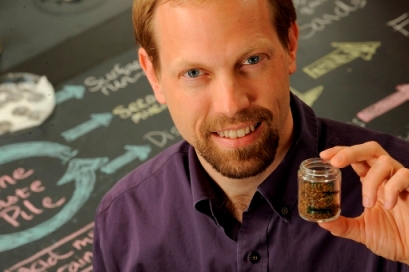Wellesley Researcher Warns Spices May Present
Health Hazard
FOR IMMEDIATE RELEASE:
March 18, 2010 |
|
WELLESLEY,
Mass.— While spices may add flavor to cooking, Wellesley College's Daniel Brabander, associate professor of geosciences, warns that certain Indian spices may be linked to lead poisoning in children.
 |
| Daniel Brabander, Wellesley College professor of geosicences, and a group of other Boston-area researchers found evidence linking Indian spices to lead poisoning in children. |
Brabander, who teaches environmental geochemistry, is among a group of Boston-area researchers who have linked at least four cases of lead poisoning in children to the use of Indian spices or ceremonial powders. Their market basket survey in the metropolitan Boston area found one-quarter of the Indian spices and other foodstuffs tested contained detectable lead levels, and more than half of the ceremonial and religious powders also contained detectable lead. The study appears in the March 15 issue of Pediatrics.
"One of the unique aspects of this work is that it goes beyond simply determining how much lead is present in Indian spices and cultural powders," Brabander said. "We evaluated the fraction of this total lead that is bioaccessible, or that readily dissolves in the stomach, and in the case of the high-lead sindoor samples, determined how the lead is chemically bound in the materials."
The two factors may increase the risk of contamination.
"The important conclusion we draw is that some of the products have the potent combination of elevated lead levels coupled with high bioaccessibility," Brabander said. "The final recommendation from our work is that clinicians who work with South Asian communities should perform targeted blood lead screening and administer lead-exposure assessment questionnaires."
Brabander and fellow Harvard researchers say immigrant children may be especially at risk for lead poisoning due to repeated exposure to these products.
"Although the powders are not meant for consumption, we speculate that infants may inadvertently be exposed by hand-to-mouth transference of topically applied powders or by the hands of parents who handle the powders and then prepare foods for the infant's consumption," writes lead author Cristiane Gurgel Lin, M.D., Ph.D., of Children's Hospital in Boston, and colleagues in Pediatrics.
Infants may also be exposed to these products in utero, through breastfeeding, inhalation or absorption through the skin. In the four cases of lead poisoning detailed in the report, all the children had improved blood lead levels after receiving treatment and/or after their parents discontinued use of the spices or powders.
The cases prompted researchers to analyze 86 imported spices and 71 ceremonial powders available at Boston-area stores. The results showed 22 of the 86 spices and food products and 46 of the 71 ceremonial powders contained detectable lead levels.
Researchers say some ceremonial sindoor powders that had been previously banned or recalled by the FDA were still available for sale and contained more than 50 percent lead.
Researchers say similar Indian spices and ceremonial powders are also available for purchase on the Internet. These results suggest the lead content of these products could pose a public health risk and merit further testing.
One 12-month-old boy in the study was found to have lead poisoning after regularly eating spices such as turmeric, black mustard seed and asafetida. When the family discontinued use of the spices, his blood lead levels went down within six months.
At Wellesley, Brabander's research emphasizes projects that cut across departmental boundaries, fostering collaboration among biology, chemistry, geosciences and environmental engineering disciplines. All of his work involves research experiences for undergraduates.
In addition to his study on spice contamination, he focuses on environmental and forensic geochemistry, researching toxic metals in watersheds, aquifers and in the urban environment.
Since 1875, Wellesley College has been a leader in providing an excellent liberal arts education for women who will make a difference in the world. Its 500-acre campus near Boston is home to 2,300 undergraduate students from all 50 states and 75 countries.
(Story includes reports from ABC News and WebMD.)
###
|

